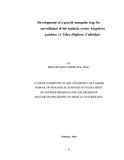| dc.description.abstract | This study was intended to develop a trap for surveillance of gravid malaria vectors,
Anopheles gambiae s.l., in outdoor venue.
First, a suite of tools were developed for studying the oviposition behaviour of
gravid An. gambiae s.l. A square of four electric nets with yellow sticky filmmounted
boards to collect electrocuted mosquitoes was developed as a tool to
quantify gravid mosquitoes approaching an oviposition site. On average 33% (95%
CI 28-38%) of mosquitoes released were recollected with the e-nets. The electric net
(e-net) setup was evaluated for any influence on the response of gravid mosquitoes
to a pond it surrounds compared to distribution of mosquitoes in two similar ponds;
it collected a higher proportion of mosquitoes (OR 1.7, 95%CI 1.1 - 2.7; p<0.017).
Following this, yellow boards placed around a pond were also tested and it attracted
more mosquitoes as well (60.6% 95%CI 47.9 – 72.0). The combination of the
yellow boards, the black pond at the centre and the surrounding floor might have
formed a preferred contrast by the mosquitoes. The yellow film might not attract by
itself as the mosquitoes hardly land on it compared with the transparent and shiny
black surfaces (OR 41.6, 95% CI 19.8 – 87.3, p < 0.001 and OR 28.8, 95% CI 14.5 –
56.8, p < 0.001, respectively). Detergent and spray glue applied to water, insect glue
applied on transparency and wire screen placed above the surface of the water (test
for landing on the surface) and spray glue, yellow sticky film and transparent
double-sided sticky film applied on the edge of artificial habitats were used to assess
the mosquitoes’ landing behaviour during oviposition. Over 80% of collected
females were found on the water surface (Mean 103, 95% CI 93-115) as compared
to the edge of the artificial pond (Mean 24, 95% CI 20-28).
The catching efficiency of commercially available gravid culicine traps were
evaluated and the square of electric net was used to investigate the factors that are
responsible for a reduced acceptability of gravid malaria vectors to approach these
traps. Only less than 30% of released mosquitoes were recollected per night by Box,
CDC and Frommer gravid traps (59.3, 95% CI 50.3–70.0). The number of
mosquitoes approaching the Box trap was significantly reduced when the trap was
xvii
positioned over a water-filled basin compared to an open pond (OR 0.7 95% CI 0.6–
0.7; p < 0.001). Based on this result a new prototype trap (OviART gravid trap) that
provides open landing space was developed for the collection of gravid malaria
vectors. The catch was significantly increased with the OviART gravid trap both in
semi-field and field systems (OR 1.6, 95%CI 1.2–2.2; p = 0.001; OR 3.3, 95%CI
1.5, 7.1 respectively) compared with the Box gravid trap.
In conclusion, a square of four e-nets with yellow sticky collection devices can be
used for quantifying the numbers of mosquitoes approaching a small oviposition
site. An. gambiae s.l. primarily land on the water surface for oviposition, a behaviour
exploited for the development of an OviART gravid trap. The OviART gravid trap
can be used as outdoor sampling tool for surveillance of malaria vectors | en_US |
| dc.description.department | a
Department of Psychiatry, University of Nairobi, ; bDepartment of Mental Health, School of Medicine,
Moi University, Eldoret, Kenya | |

